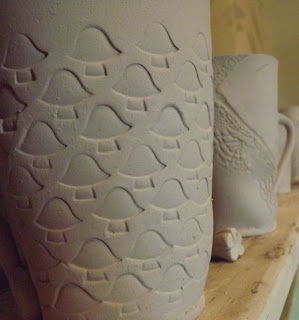 |
| Smaller child size mugs, this one personalized for N, I love how it looks, I may have to do one for myself too. |
 |
| This one is for my niece- the lace may be too girly for her- but I think a nice black glaze will win over her pre teen heart. |
 |
| Lots and lots of running this week, mostly with manic looks of glee on her face. |
I have got a few more mugs made this week, I'm actually finding that I can make about 10 in one day- then put handles on the next day, or about five with handles in the time that I can also keep N busy with a show on her travel DVD, (not the best parenting techniques, I know, but I've got to get some work done right?). After that she wants to 'help' me, or to eat chocolate chips non-stop, and that's not good for anybody. Of course I still have to finish smoothing them and shaping the handles before they get into the kiln, but it's been making me feel pretty productive anyhow.
I've been working on a couple of different sizes of mugs, the first ones I made were so giant they would give me a crazy caffeine rush If I drank a whole one. So a few new sizes including a child's size, will go into this batch, and hopefully one of them will be just perfect once fired. (Clay shrinks as it goes through it's drying and firing processes, so it's always a bit of a guessing game as to what the end size will be, there are people who can figure this out with precise tests and Math- I am not one of them)
I'm planning on firing a glaze kiln this weekend too- a few test glazes for some new colours, I want to get a nice spring green colour, and maybe an orange one as well, but I'm not sure I can do it from my current colours. I use stains to get my glaze colours, in the same clear base glaze for ease, and I generally love them, I have used oxides in the past, but it's more difficult to get a bright candy coloured hue, if it's at all possible. The other thing I love about Mason stains is that they seem to mix like paint- as in a blue stain and a yellow stain will make a green one, which mostly doesn't happen with oxides as they derive colour from chemical interactions, not pigments.
This is how I think they work after a few experiments, but I don't know if they all work like that- or if it's just that particular yellow stain, with that particular blue one that just happen to make green, (if it is just some random thing then that is just the pottery god's way of screwing with painters who make pottery). Anyhow, I plan to do a big glaze test using all my colours and mixing them methodically to see what else crops up.






